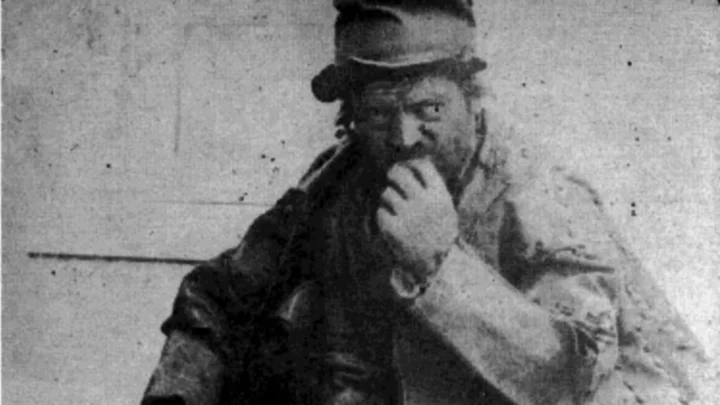Virtually every month during the school year in the late 1800s, students attending class in Branford, Connecticut, would get an unexpected recess. At the urging of their teacher, they’d file out of classrooms, stand outside, and start searching for any sign of him.
Soon, like clockwork, he would appear—a man dressed head to toe in leather. A heavy leather coat over leather slacks and shirt. A leather hat and leather boots. A leather satchel and leather hat.
Where he came from, no one knew. What he ultimately wanted, no one could say. Nor would he: To most, he would simply grunt, or speak a few sentences in French, before going on his way.
His trek was a clockwise walk through Connecticut and parts of New York, a 365-mile journey he could complete in roughly 35 days, and one he repeated in a seemingly endless loop. Like the students, the residents of the towns he passed through were fascinated by the enigmatic visitor. And since he didn’t divulge his name, they had to give him one: the Old Leatherman.
Sightings
From his manner of dress to his nickname, the Leatherman presents as a kind of urban legend or regional boogeyman. But contemporaneous accounts of him are plentiful, as are photos and eyewitnesses. There’s no question the Leatherman was not only real, but a common presence in the latter half of the 19th century. What remains a mystery is the man behind the folklore.
The Leatherman was first spotted in the 1850s—different accounts put it at either 1852 or 1857—in and around Connecticut. He would materialize in towns like Portland, Burlington, and Greenwich, walking through while clad in his distinctive sartorial garb, all cowhide with the exception of his wooden soles. He was estimated to stand about 5 feet, 7 inches, and had dark hair. The rustling of the leather was said to be audible, a clue the Leatherman was approaching.
“The Leatherman had fair skin and if he had shaved off his whiskers, he would have been a very fine looking man, and if he dressed like everybody else,” said Anna Church, a local who saw him as a child and later spoke of him in 1948.
He exhibited no aggression, was never noted to steal any property, and kept to himself. If any townspeople were initially wary of him, his misanthropy put an end to it. The Leatherman didn’t want to be bothered and therefore didn’t bother others.
“He was never seen walking in the road,” Church said, “always on the side. He never looked at people, but children were not afraid of him. They just watched. Sometimes boys put plug tobacco on the fence for him but he would not take it. He would pick up all the cigar stubs he could find.”
He would, however, accept other sorts of hospitality. Once locals became familiar with the Leatherman, they’d offer fresh bread, stew, and other meals, which he would happily consume. Other times, he’d eat at the Middlesex County Jail, which had a garden and dairy farm. If people were too inquisitive as to where he was from or where he was going, he wouldn’t visit them again.
“We could see him coming a quarter of a mile down the road,” one eyewitness, Mary Reynolds, wrote of the Leatherman. “Mother would fix a plate and a cup of coffee and hand it to him. He would place it on the cistern, then after eating, knock on the door, hand the plate in, nod his head and walk on.”
He also had money. At Harding’s Grocery in Branford, he had a typical order: a loaf of bread, a can of sardines, coffee, crackers, pie, beer, and brandy. In his satchel he had a frying pan for cooking.
Shelter wasn’t an issue, either. Over time, the Leatherman set up accommodations in caves, stocking firewood and other supplies so he could sleep before resuming his trek the following day. These havens were sometimes handmade, consisting of rocks with poles for a roof.
He also tended to his hygiene. He cleaned himself in streams, though his appearance led at least one outlet—The New York Times—to describe him as “uncouth, repulsive, and wholly inexplicable.”
His wandering was often the subject of scrutiny. At one point, a curious resident obscured a camera by tucking it under blankets on a clothesline and snapped a photo of the Leatherman. Another photograph of him aroused such interest it was put on display in a window.
The Leatherman’s trek went on for decades, regardless of weather. In the summers, he endured blistering heat in the suit. In the winters, he braved freezing temperatures and at least one blizzard. He was known to be so punctual in his route that in 1886, when he had not stopped by his usual haunts, some feared he had died in inclement weather.
By that time, it became clear his loop had grown to encompass 365 miles; the Leatherman walked a little more than 10 miles a day. He became such a part of the local fabric that a rumor emerged that 10 Connecticut villages made sure he was exempt from a so-called “tramp law” that prohibited vagrancy. In fact, there’s no evidence he was excused from the law, though perhaps police avoided bothering him. Despite his formidable presence, he was harmless—but that still didn’t explain who he was or why he felt compelled to keep walking in an endless circle.
Missing
In 1888, the Leatherman was detained for what may have been the only time. Agents of the Connecticut Humane Society—which was then concerned with the well-being of both people and animals—met him at a home he was known to stop at for meals. A physician diagnosed him with mouth cancer, likely from his tobacco habit. He was talked into being seen at a facility. The agents warned hospital staff that the Leatherman might grow uncooperative if attempts were made to separate him from his suit, and that they should keep a close eye on him because he would probably try to escape. Sure enough, he left just minutes after being dropped off.
“He will now probably change his route, but seems likely to pursue his vagabond life until stricken down by his final sickness,” wrote The Meriden Daily Republican.
It was a prophetic statement. In March 1889, the Leatherman’s body was discovered in Saw Mill Woods cave in Mount Pleasant, New York. An autopsy revealed his rough age—he was in his fifties—and that he had died due to blood poisoning from oral cancer. His belongings were also evaluated, which led to the discovery of the massive physical burden he was carrying: His leather outfit, all made from patches of boots sewn together and subject to endless repairs, weighed 60 pounds.
The Leatherman had also been carrying a French prayer book. That, along with his occasional mutterings in French, led to the belief he was from France, or perhaps French-Canadian. But none of his personal effects revealed a name or birthplace, which freed people up to create their own mythology.
One theory was that he had married into a leather fortune, only to kill the patriarch—his wife’s father—by accidentally setting their house on fire. Another story had it that he was Jules Bourglay of Lyons, France, whose poor business acumen had lost the leather fortune, prompting his wife to leave him and the Leatherman to flee in shame. The walk became a kind of penance he placed upon himself. The name Jules Bourglay was eventually etched on his tombstone even though the story turned out only to be the premature speculation of a newspaper upon his death in 1889.
The most intriguing tale came from a journalist who claimed he had succeeded in engaging the Leatherman in extended conversation. The wanderer, he said, was Rudoph Mossey, a shoemaker from France who followed his estranged wife to Connecticut. While there, he learned she had died. Distraught, he began retracing her steps around the area. None of it could be proven to be anything other than apocryphal.
The Leatherman’s burial plot was located in Sparta Cemetery in Ossining, New York. Over time, it grew into a popular tourist destination. But by 2011, the curiosity was turning into something dangerous. The plot was near a highway, and town officials worried someone visiting his grave might be hit by a car. Plans were made to relocate the site to a safer part of the cemetery. Since that was being done, officials at the Ossining Historical Society also figured it would be a good time to exhume the Leatherman and see if his DNA might reveal evidence of his true heritage.
It was a good plan, save for one thing: The Leatherman’s grave was empty, with only a few coffin nails remaining. It was thought that, because the roadway had been expanded over the grave, heavy traffic had prompted the body to disintegrate. It was also possible a road grading project had led to part of the grave being disturbed, dug up, and discarded.
The site was relocated to keep visitors safe from the highway, this time with a plaque and coffin rather than the humble pauper’s grave he was originally placed in; inside were nails and soil from his initial resting place. To date, no one has yet come up with conclusive answers about his origin, what drove him to wander, or why his grave was empty. To some, the ambiguity was fitting: The Leatherman never could stay in one place too long.
This article was originally published on www.mentalfloss.com as The Eerie Legend of the ‘Old Leatherman,’ Connecticut’s Silent Wanderer.









